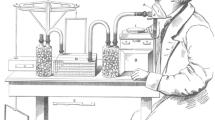Abstract
A chamber for indirect calorimetry has been constructed that utilises previously published general equations for the calculation of respiration. Owing to the large size of the chamber, the changes in gas concentration caused by a subject are very small. Therefore, algorithms are developed for noise suppression and trend identification. Using the exact solution of the equations for steady state, each gas concentration is fitted by a least square method to two connected exponential segments, of variable length, for the preceding 30 min period. Independently of the location of the join between the two segments, the gas concentration and its time derivative are evaluated at −15 min. This process is repeated, and its results are presented once every minute. As proven by gas injection tests, this procedure gives an instantaneous response to a single change in respiration, a correct averaging of repeated changes in respiration with periods of less than 15 min and noise suppression. It is concluded that this chamber is useful not only for traditional 24 h energy expenditure measurements, but also for experiments requiring rapid responses.
Similar content being viewed by others
Abbreviations
- d/dt :
-
time derivative, s−1
- F :
-
flow rate, in or out of chamber, m3s−1
- f :
-
fractional concentration
- p :
-
absolute pressure, Pa
- R :
-
rate of gas production, m3s−1(STP)
- t :
-
time, s
- V :
-
gas volume of chamber, m3
- Ψ:
-
conversion factor to dry STP conditions
- EE :
-
energy expenditure, J
- C :
-
carbohydrate oxidised, kg
- F :
-
fat oxidised, kg
- P :
-
protein oxidised, kg
- N :
-
nitrogen excretion in urine, kg
- c :
-
constant
- CO 2 :
-
carbon dioxide
- d :
-
dry
- G :
-
any gas
- i :
-
in-going
- N 2 :
-
nitrogen
- o :
-
out-going
- O 2 :
-
oxygen
- r :
-
rate of change
- w :
-
water vapour
References
Abramson, E. (1943): ‘Computation of results from experiments with indirect calorimetry’,Acta Physiol. Scand. 6, pp. 1–19
Astrup, A., Thorbek, G., Lind, J., andIsaksson, B. (1990): ‘Prediction of 24-h energy expenditure and its components from physical characteristics and body composition in normal-weight humans’,Am. J. Clin. Nutr.,52, pp. 777–783
Brown, D., Cole, T. J., Dauncey, M. J., Marrs, R. W., andMurgatroyd, P. R. (1984): ‘Analysis of gaseous exchange in opencircuit indirect calorimetry’,Med. Biol. Eng. Comput.,22, pp. 333–338
Dulloo, A. G., Ismail, M. N., Ryall, M., Melas, G., Geissler, C. A., andMiller, D. S. (1988): ‘A low-budget and easy-to-operate room respirometer for measuring daily energy expenditure in man’, Am. J. Clin. Nutr.,48, pp. 1367–1374
Hill, J. O., Peters, J. C., Reed, G. W. Schlundt, D. G., Sharp, T., andGreene, H. L. (1991): ‘Nutrient balance in humans: effects of diet composition’, Am. J. Clin. Nutr.,54, pp. 10–17
McLean, J. A., andTobin, B. (1987): ‘Animal and human calorimetry’, Cambridge University Press, UK
Moon, J. K., Vohra, F. A., Valerio Jimenez, O. S., Puyau, M. R., andButte, N. F. (1995): ‘Closed-loop control of carbon dioxide concentration and pressure improves response of room respiration calorimeters’, J. Nutr.,125, pp. 220–228
Murgatroyd, P. R., Davies, H. L., andPrentice, A. M. (1987): ‘Intraindividual variability and measurement noise in estimates of energy expenditure by whole body indirect calorimetry’, Br. J. Nutr.,58, pp. 347–356.
Murgatroyd, P. R., Shetty, P. S., andPrentice, A. M. (1993): ‘Techniques for the measurement of human energy expenditure: a practical guide’,Int. J. Obes.,17, pp. 549–568
Pettenkoffer, M. (1862): ‘Über die Respiration, Annalen der Chemie und Pharmacie’,123,Suppl. 2, pp. 1–52.
Ravussin, E., Lillioja, S., Anderson, T. E., Christin, L., andBogardus, C. (1986): ‘Determinants of 24-hour Energy Expenditure in Man’,J. Clin. Invest.,78, pp. 1568–1578
Shetty, P. S., Sheela, M. L., Murgatroyd, P. R., andKurpad, A. V. (1987): ‘An open-circuit indirect whole body calorimeter for the continuous measurement of energy expenditure of man in the tropics’,Indian J. Med. Res.,85, pp. 453–460.
Valencia, M. E., McNeill, G., Brockway, J. M., andSmith, J. S. (1992): ‘The effect of environmental temperature and humidity on 24 h energy expenditure in men’,Br. J. Nutr.,68, pp. 319–327
Van Es, A.J.H. (1984): ‘Results of enquiry on calorimetric equipment and experimental routines for studies in which human energy metabolism is followed for 24 h and longer, Human energy metabolism: Physical activity and energy expenditure measurements in epidemiological research based upon direct and indirect calorimetry’. Euro-Nut Report 5, EC Workshop, Wageningen, The Netherlands, 24–26 October 1984, pp. 19–29.
Veitl, V. (1984): ‘Direct and indirect measurement of energy output in man,’ibid, Euro-Nut Report 5, EC Workshop, Wageningen, The Netherlands, 24–26 October 1984, pp. 93–107.
Author information
Authors and Affiliations
Rights and permissions
About this article
Cite this article
Henning, B., Löfgren, R. & Sjöström, L. Chamber for indirect calorimetry with improved transient response. Med. Biol. Eng. Comput. 34, 207–212 (1996). https://doi.org/10.1007/BF02520075
Received:
Accepted:
Issue Date:
DOI: https://doi.org/10.1007/BF02520075




